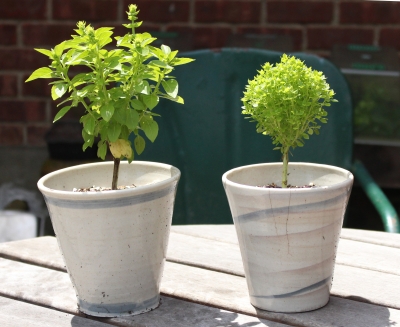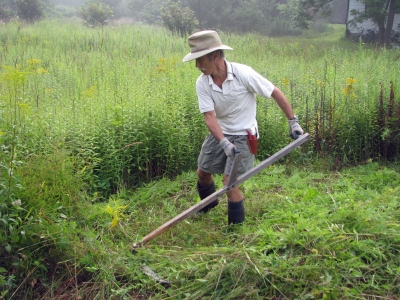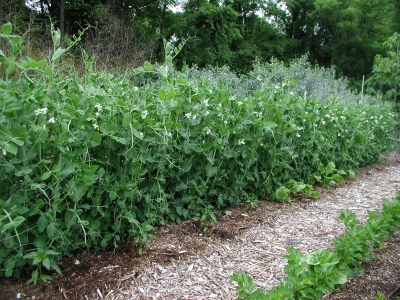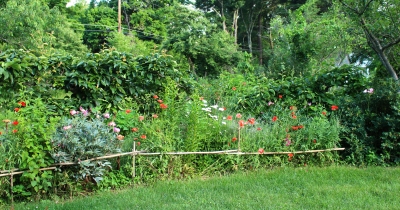Farmden Health Club & Basil
/1 Comment/in Gardening, Tools, Vegetables/by Lee ReichRei-King, an Ancient Exercise?
Among the many benefits of gardening is the opportunity it offers for enjoyable, productive exercise in the great outdoors. And now we can add an exercise called rei-king to boot camp, pilates, zumba, kick boxing, cardiofunk, and other ways modern humans build and maintain sleek, fit bodies. Or so I told my wife, Deb.
As with some of those other exercise routines, equipment is needed, simple equipment in the case of rei-king. Basically, the equipment is a pole, perpendicular to and at the end of which is a length of wood or metal, attached in its middle to the pole. From the lower side of the length of wood or metal are teeth, each a couple of inches apart and a couple of inches long.
Now for the exercise. You lift the pole just enough to bring the head off the ground, reach forward, and pull it towards you. For balanced exercise, it’s advised to occasionally switch which arm is most forward.
Resistance is the way to build up muscle and endurance. That resistance comes in the form of friction from material lying on the ground. This time of year, that material might conveniently be mown long grass or hay.
And Sie-Thing
I sometimes practice rei-king; more often I choose another exercise that complements Deb’s rei-king. I practice sie-thing (pronounced “sigh-thing”).
Like rei-king, sie-thing entails using one piece of equipment, a sie. The sie also has a single pole, in this case with two handles attached, one at the upper end and one about halfway down. A metal weight is attached at the bottom of the sie. The metal is a couple of feet long, curved, and sharpened on its inside edge. Muscle tone and strength is created by putting the left hand on the upper handle, the right hand on the lower handle, flexing the spine to the right and then unwinding it to the left while trailing the metal weight just above ground level.
Again, sei-thing can be made more rigorous, in this case by passing the sharp metal through tall grass or meadow plants. The taller the plants, the denser the plants, and the older plants, the more the resistance.
A side benefit of all this sie-thing is that grass or meadow plants get mown during the exercise. The fallen material drops right in place, providing an opportunity — for me or, more usually, Deb — to then practice rei-king.
By the way, either exercise is most enjoyable early in the morning. At that time, plants are turgid so the sharpened metal of the sie pops plant cells as it is drawn along. And the fallen plants, best for rei-king after lying on the ground a day or two to wilt, cling together nicely when heavy with dew. The cool morning air is also conducive to exercise.
Basil for Winter?
Many years ago I grew the few varieties of basil that were available and then wrote about them. My conclusion, at the time, was that taste differences between the varieties were minor, so the choice of what to grow should perhaps be on the fun of saying their names, which put Genova Profumatissima, Syracusa, and Fino Verde Compatto at the top of the list. What fun to wave my arms and speak their names!
Or, a variety could be chosen for the size or color of its leaf, whether for decoration or culinary use. “Spicy Globe basil, planted close together, makes soft, green mounds resembling a miniature boxwood hedge,” I wrote. Now we have yet another decorative form: Bonsai Basil.
To create a bonsai basil, a variety such as Spicy Globe — perfect, with its diminutive, closely spaced leaves — is grafted onto a special rootstock. That rootstock is another variety of basil, one chosen, in perfect world, to impart to the grafted plant vigor, disease resistance, and hardiness. Periodically shearing such a plant keeps up appearances even as it provides basil for flavoring. Over time, the trunk even turn woody.
Even better, carry on the fun and the flavor through winter. Basil is perennial in the tropics but generally does not fare well in the cool, dry air, and relatively dark conditions of a northern home in winter. All of which calls out for a vigorous, disease-resistant, hardy plant. A grafted basil. Grafted basil, even more than grafted tomatoes, are very much the new kid on the (grafted) block.
A few weeks ago I was given a couple of grafted bonsai basil plants and I’m planning to grow them as perennials. It turns out that my plants are on a rootstock called Nufar which is resistant to fusarium disease. My soil doesn’t harbor basil fusarium disease, so that rootstock is of no benefit in that department. Perhaps it will help get the plant through the long, dark winter indoors anyway.
New rootstocks that could impart vigor and hardiness to help get a bonsai basil through winter — indoors, of course, around here — are on the horizon.
————————————————-
Ah, fusarium. Reminds me of last week’s patting myself on my back about my conquest of pea fusarium, which has plagued me for years. Well, between last week and this week, fusarium has again reared its ugly head and the vines have yellowed. I did get a decent crop, however. Looks like management rather than conquest will be the key to annual harvests of peas.
Peas Please Me
/1 Comment/in Soil, Vegetables/by Lee ReichIn some gardening circles, a gardener’s worth is measured by how well he or she grows peas: how soon the first pea gets to the table, the crop’s abundance, and, of course, the flavor. Sad to say, I haven’t been able to grow peas well for about 10 years.
 Peas require a humus-y, moisture retentive soil and early planting, all of which I provide. But about 10 years ago, just as the crop was coming on strong, vines began to turn yellow, leaves would flag, and plants would die. The probable cause was fusarium wilt disease (caused by Fusarium oxysporum). This soil-borne fungus invades plant roots and then clogs up the vascular system.
Peas require a humus-y, moisture retentive soil and early planting, all of which I provide. But about 10 years ago, just as the crop was coming on strong, vines began to turn yellow, leaves would flag, and plants would die. The probable cause was fusarium wilt disease (caused by Fusarium oxysporum). This soil-borne fungus invades plant roots and then clogs up the vascular system.
(You may have heard of fusarium wilt of tomatoes and other vegetables. Fear not spread of fusarium among these vegetables, because different vegetables have their own fusarium subspecies. Cucumbers have F. oxysporum f.sp. cucumerinum, canteloupes have F. oxysporum f.sp. cubense, and peas have F. oxysporum f.sp. pisi. How cozy.)
Fusarium wilt probably never made it past my garden gate. It was probably already in my soil at some low level. Over the years, I’m guessing that it built up to a critical mass and was inadvertently spread — by me — on trowels, boots, and tellising. Which leads to one way to keep the disease in check: Clean trowels before planting peas; clean hoes before hoeing peas; and clean or torch the chicken wire trellises and metal support posts that keep the vines off the ground.
Some pea varieties are resistant to fusarium disease. But there are a few races of the disease. A variety resistant to one race may be susceptible to another race. Planting a resistant variety one year did not ratchet up my “good gardener rating.” The plants succumbed to the disease as in other years, and understandably so since I did not know which fusarium race I was up against, and variety descriptions for wilt resistant peas don’t always specify to which wilt race the variety is resistant.
Fusarium conquered(?)
This year I’m back in the game again with peas — and an excellent harvest it is: abundant, early, and flavorful! (These are shelling peas, which take longer to mature than snap peas or snow peas, but also taste better even if they do need shelling.)
One thing that I did this spring — the thing that I’m touting as responsible for my good crop — was to plant the pea seeds in my south vegetable garden, where I haven’t grown peas for the past 6 years. My wan efforts over the years have been plantings in my north vegetable garden, and they have been consistent failures.
F. oxysporum f.sp. pisi survives from year to year in the soil as spores, very hardy spores. So hardy that the recommendation is frequently made not plant peas again, ever again, in tainted soil. Other recommendations are to wait 5 or 10 years before replanting. In either case, of course, it’s necessary to be very careful about spreading the disease again on tools, boots, or trellises.
And again, the ideal would be to plant disease resistant varieties.
Good rotations
People sometimes ask me if I rotate my crops each year. Crop rotation does not involve twirling plants; it’s moving certain plants — be they in a botanical family or part eaten — to different parts of the garden each year.
In the case of plant families, it’s a way to reduce pest problems because family members may host the same pest (clubroot disease of broccoli, cabbage, turnips, and radishes, for example). A pest that overwinters in the ground will eventually starve if a suitable host is not on hand on which to feed. A pest that flies or that shoots spores far and wide can travel some distance to find a host, but that, fortunately, is beyond the capacity of many pests.
In the case of rotating by part eaten, such as leaf, fruit, or root, the idea is to balance nutrient uptake. Leafy vegetables are hungry for nitrogen, root vegetables for potassium, and fruiting vegetables for phosphorus.
It’s generally safe to rotate vegetables on a three year cycle. That is, not to return a vegetable in the same family or with the same part eaten to the same place sooner than within 3 years. Planting in beds makes this easy because once the garden is planned out, you just move the crop to the next bed, or two beds away for further distance, each year.
 Do I rotate my crops? You betcha’. With peas, I’ll try the 3 year rotation in the south vegetable garden. And I’ll wait at least another 5 years before planting them again in the north vegetable garden, then giving the south garden a “rest” from them. It’s good to again be unzipping green pods and scooping out the sweet peas within.
Do I rotate my crops? You betcha’. With peas, I’ll try the 3 year rotation in the south vegetable garden. And I’ll wait at least another 5 years before planting them again in the north vegetable garden, then giving the south garden a “rest” from them. It’s good to again be unzipping green pods and scooping out the sweet peas within.
Serendipity Strikes!! & Join Me in Seattle
/2 Comments/in Design, Tools/by Lee ReichJoin me in Seattle on August 10, 2014 for a talk I’ll be giving on “Luscious Landscaping — With Fruiting Trees, Shrubs, and Vines!”. Luscious landscaping is the way to beautify your yard and, at the same time, to put (very) local, healthful, flavorful food on the table. Following the lecture, we will explore the gardens at Magnuson Park. For more information about this event, go to http://leereich.brownpapertickets.com.
Ice Cream for Poppies
I first learned the word “serendipity” when I was in junior high school; it was the clever name of an ice cream shop that my parents had come upon in New York City. I’ve been on the lookout for it ever since: the word, not the shop. And I find it, occasionally, in the garden.
Like yesterday, for instance. Last March I sprinkled corn poppy (Papaver rhoeas) seeds on a flower bed that’s also home to espaliered Asian pears and a plum tree. Looking down at the dust-like seeds in the palm of my hand, it would have been hard to imagine that they could ever amount to anything. Especially since I did nothing more than sprinkle them on top of the ground, the whole packet.
But the seeds did amount to something, to more than just something, to oodles and oodles of two-foot-long stems capped by orangish red blossoms. The color is similar to that of Oriental poppies (P. orientale), but corn poppy flowers are smaller and more delicate, “all silk and flame,” to quote John Ruskin. Not exactly a serendipitous planting because I did, after all, sow the seeds. But I could hardly have predicted the exuberant response.
In amongst other plants, the flowers are held high. At the front edge of the bed, though, the dainty heads flop down on the lawn. Which would be okay, except that it would be a shame to mow those silky blossoms when mowing the lawn at the bed’s edge. Likewise, it would be a shame to let the grass grow unfettered up around and hiding the blossoms. Too messy.
So yesterday I propped the floppy plants up with a fence. Nothing fancy or permanent, just five short bamboo canes pushed into the ground about eight feet apart as posts. The crosspieces, four long bamboo canes each slid along the lawn beneath the flowers, were then lifted and lashed to the short canes a foot above the ground.
Serendipity. Not only are the flowers up off the ground but the bamboo “fence,” simple as it is, greatly improved the appearance of the bed, visually defining it to better highlight the plants.
Tea Crabs into a Tea Hedge, with a Doorway
My most serendipitous planting was many, many years ago, of tea crabapples (Malus hupehensis). I was using these plants for research when I was working for Cornell University. I needed clones, and tea crabapple has the quirk of apomixis, which means that its seeds do not reflect the sexual union of pollen with egg cells; the seeds are formed only from mother tissue so grow into clones of each other and the mother plant.
Starting many tea crabapples from seed left me with extra plants, so I took eight home and planted them in a tight row, with only a couple of feet between plants, along and about five feet from the back edge of my garage/barn. What was I thinking? Tea crabapple can grow 40 feet high and wide!
As the plants grew, I sheared them into a hedge 10 feet high and 4 feet wide. After a few years, I put a rear, sliding door on the back of the garage/barn. Rather than walk out that door into a tree, I cut out one of the crabapples, and sheared a living doorway through the row of remaining trees.
I subsequently planted a privet hedge that runs perpendicular to the north edge of the crabapple hedge. Because the privet hedge is only about 3-feet-high, I decided to meld it with the crabapple hedge by letting it swoop upwards at their meeting. Access was needed through the privet hedge also, so another arch was created, this one higher and wider to let my tractor pass through.
It’s all very playful and, to me, pretty. And it all started with a mindless planting of extra tea crabapples.
Shearing Easily
The height and length of these hedges present maintenance challenges. Years ago, scissoring hedge shears made the work pleasant but very slow. The top of the crab hedge demanded my climbing a ladder and swinging a shearing knife — a dangerous proposition.
Technology has come to the rescue. Nowadays both hedges are kept trim and neat with two tools, both powered by 20 volt lithium batteries. What I can reach gets clipped with a Black & Decker battery powered hedge trimmer. Thanks to my Black & Decker battery powered pole hedge trimmer, the 10-foot-high hedge no longer demands a ladder. The trimmer’s articulating head makes it easy to give the upper sides a 45 degree cut and then, after repositioning the blades at 90 degrees, to make a flat cut along the top of the hedge.
The pole trimmer is especially important for making it convenient to cut high up on a hedge, the part most likely to be neglected especially on tall hedges. Hormones within every plant favor most vigorous growth highest up in the plant. So the top of the hedge, left to its own devices, would naturally overgrow the lower portions, leading to shading and bare branches lower down. Keeping the upper part of the hedge narrower than the bottom counteracts this tendency.








